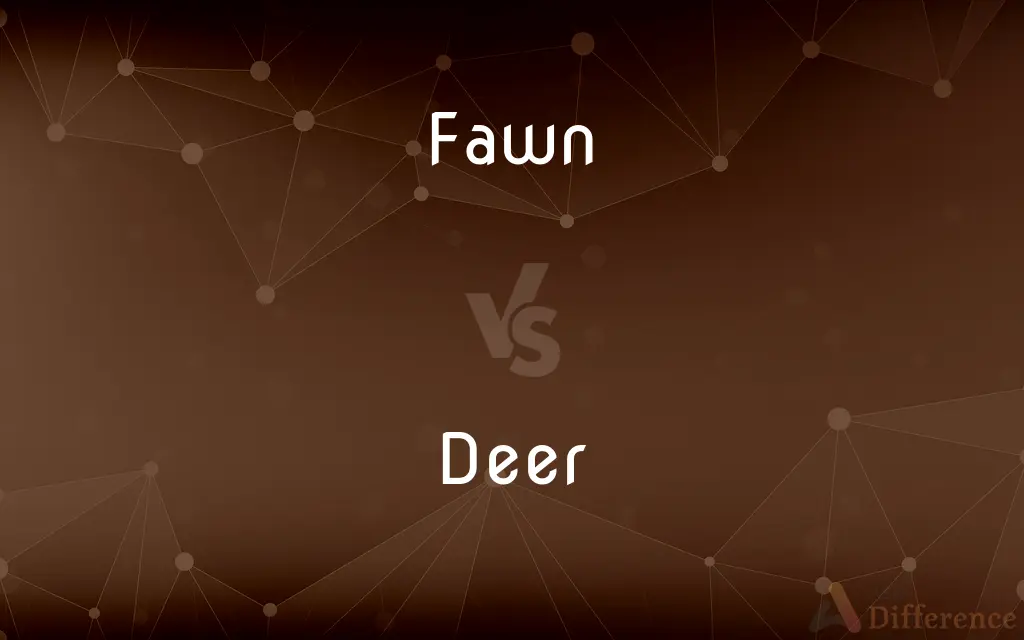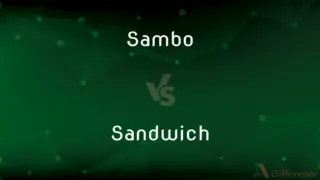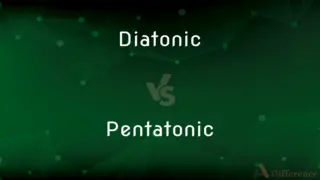Fawn vs. Deer — What's the Difference?
By Urooj Arif & Maham Liaqat — Updated on April 26, 2024
Fawn refers to a young deer, typically less than a year old, characterized by its small size and spotted coat; a deer is a fully grown animal of the species, larger and usually spotless.

Difference Between Fawn and Deer
Table of Contents
ADVERTISEMENT
Key Differences
Fawns are young deer, identifiable by their spotted coats, which serve as camouflage. While deer, depending on the species, grow out of these spots as they mature into their adult coat.
Fawns depend heavily on their mothers for protection and nourishment, whereas adult deer are more independent and capable of fending for themselves.
Fawns are generally more vulnerable to predators due to their size and lack of experience, on the other hand, adult deer have better survival skills and can escape predators more effectively.
Fawns' diets are primarily milk from their mothers in the initial months, while adult deer have a varied diet that includes leaves, twigs, fruits, and nuts.
The behavior of fawns is characterized by periods of rest and hiding to avoid predators; adult deer, however, are more active and engage in foraging and social behaviors within their herd.
ADVERTISEMENT
Comparison Chart
Age
Less than a year old
Any age after one year
Size
Smaller, lighter
Larger, heavier
Coat Pattern
Spotted for camouflage
Generally solid; varies by species
Diet
Milk from mother initially
Leaves, twigs, fruits, nuts
Behavior
Hides and depends on mother
More independent and mobile
Compare with Definitions
Fawn
Highly dependent on maternal care for survival.
The fawn bleated softly, calling for its mother.
Deer
Known for their agility and speed.
The deer darted through the woods at the slightest sound.
Fawn
A young deer in its first year of life.
The fawn stayed close to its mother in the tall grass.
Deer
A hoofed mammal known for its antlers, typically found in forested areas.
The deer grazed quietly by the riverside.
Fawn
Noted for its distinctive spotted coat.
The fawn's spots help it blend into the forest floor.
Deer
Can vary widely in size depending on the species.
The majestic elk is one of the largest species of deer.
Fawn
Vulnerable to predation in its early life.
Predators often target fawns due to their small size and inexperience.
Deer
Seasonally, males may grow and shed antlers.
The buck's new antlers were just beginning to form.
Fawn
Begins to forage for solid food a few months after birth.
The fawn nibbled cautiously on fresh leaves.
Deer
Often forms herds for social structure and protection.
A herd of deer crossed the trail in the early morning.
Fawn
A young deer in its first year
A six-month-old roe fawn
Deer
Deer or true deer are hoofed ruminant mammals forming the family Cervidae. The two main groups of deer are the Cervinae, including the muntjac, the elk (wapiti), the red deer, the fallow deer, and the chital; and the Capreolinae, including the reindeer (caribou), the roe deer, the mule deer, and the moose.
Fawn
A light brown colour
A fawn dress
Soft shades of pale green and fawn
Deer
Any of various hoofed ruminant mammals of the family Cervidae, characteristically having deciduous antlers borne chiefly by the males. The deer family includes the white-tailed deer, elk, moose, and caribou.
Fawn
(of a deer) produce young
The forest was closed for hunting when the does were fawning
Deer
A ruminant mammal with antlers and hooves of the family Cervidae, or one of several similar animals from related families of the order Artiodactyla.
Fawn
(of a person) give a servile display of exaggerated flattery or affection, typically in order to gain favour
Congressmen fawn over the President
Deer
(in particular) One of the smaller animals of this family, distinguished from a moose or elk
I wrecked my car after a deer ran across the road.
Fawn
To exhibit affection or attempt to please, as a dog does by wagging its tail, whining, or cringing.
Deer
The meat of such an animal; venison.
Oh, I've never had deer before.
Fawn
To seek favor or attention by flattery and obsequious behavior.
Deer
Any animal, especially a quadrupedal mammal as opposed to a bird, fish, etc.
Fawn
A young deer, especially one less than a year old.
Deer
Any animal; especially, a wild animal.
Mice and rats, and such small deer.
The camel, that great deer.
Fawn
A grayish yellow-brown to moderate reddish brown.
Deer
A ruminant of the genus Cervus, of many species, and of related genera of the family Cervidæ. The males, and in some species the females, have solid antlers, often much branched, which are shed annually. Their flesh, for which they are hunted, is called venison.
Fawn
A young deer.
Deer
Distinguished from Bovidae by the male's having solid deciduous antlers
Fawn
A pale brown colour tinted with yellow, like that of a fawn.
Fawn
(obsolete) The young of an animal; a whelp.
Fawn
(rare) A servile cringe or bow.
Fawn
Base flattery.
Fawn
Of the fawn colour.
Fawn
(intransitive) To give birth to a fawn.
Fawn
(intransitive) To exhibit affection or attempt to please.
Fawn
(intransitive) To seek favour by flattery and obsequious behaviour (with on or upon).
Fawn
To show devotion or submissiveness by wagging its tail, nuzzling, licking, etc.
Fawn
A young deer; a buck or doe of the first year. See Buck.
Fawn
The young of an animal; a whelp.
[The tigress] . . . followeth . . . after her fawns.
Fawn
A fawn color.
Fawn
A servile cringe or bow; mean flattery; sycophancy.
Fawn
Of the color of a fawn; fawn-colored.
Fawn
To bring forth a fawn.
Fawn
To court favor by low cringing, frisking, etc., as a dog; to flatter meanly; - often followed by on or upon.
You showed your teeth like apes, and fawned like hounds.
Thou with trembling fear,Or like a fawning parasite, obeyest.
Courtiers who fawn on a master while they betray him.
Fawn
A color varying around light grayish brown;
She wore a dun raincoat
Fawn
Young deer
Fawn
Show submission or fear
Fawn
Try to gain favor by cringing or flattering;
He is always kowtowing to his boss
Fawn
Have fawns;
Deer fawn
Common Curiosities
What defines a fawn?
A fawn is a juvenile deer, particularly within its first year, recognized for its spotted coat.
Do all deer species have fawns with spots?
Most deer species have fawns with spots, though the patterns and duration the spots remain can vary.
What predators threaten fawns?
Common predators include wolves, coyotes, and large cats, depending on the region.
Can fawns eat solid food?
Fawns start to nibble on solid food a few months after birth but remain dependent on milk for the early part of their life.
At what age does a fawn become a deer?
A fawn is generally considered a deer once it reaches one year of age and loses its juvenile spots.
Why are fawns spotted?
The spots on a fawn serve as camouflage, helping them blend into their natural habitat to evade predators.
How long do fawns stay with their mothers?
Fawns typically stay with their mothers for up to a year, though this can vary among species.
What is the main difference in behavior between a fawn and an adult deer?
Fawns are more dependent and less mobile, relying heavily on hiding and their mother's protection, while adult deer are more independent and active.
How do deer communicate?
Deer use a variety of sounds, body language, and scent marking to communicate with each other.
Are deer nocturnal or diurnal?
Deer can be either, often being most active at dawn and dusk, which is known as being crepuscular.
Share Your Discovery

Previous Comparison
Sambo vs. Sandwich
Next Comparison
Diatonic vs. PentatonicAuthor Spotlight
Written by
Urooj ArifUrooj is a skilled content writer at Ask Difference, known for her exceptional ability to simplify complex topics into engaging and informative content. With a passion for research and a flair for clear, concise writing, she consistently delivers articles that resonate with our diverse audience.
Co-written by
Maham Liaqat













































